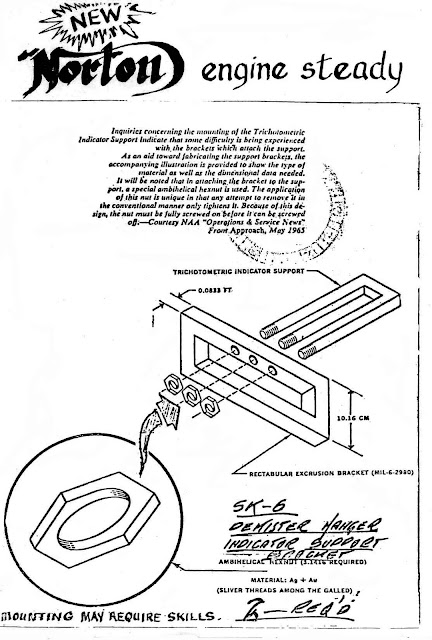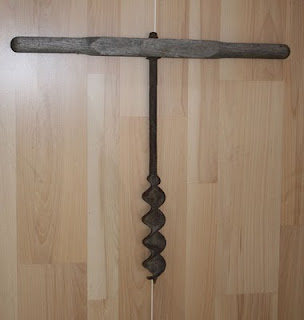Find the motorcyclist hidden somewhere in the picture. Hint: you may need to rotate the picture.
Monday 4 April 2011
Brad Awls
Brad awls are pushed into a wooden surface to create a hole for starting screws. Scratch awls are generally finer and are used to scratch lines on wood to mark where cuts, etc. are to be made.
One of the above awls was made by W. Marples & Sons in Sheffield, England. In 1821, William Marples Junior joined his father’s joinery making business, and the company was founded in 1828. In 1860, his sons joined him and the firm became William Marples and Sons. Over the years, they acquired John Moseley & Sons (London plane makers) and Thomas Ibbotson & Co. (Sheffield edge tool makers). Their shamrock trademark is stamped on the awl and was used as the name of their tools beginning in 1937.
In 1961, they had about 400 employees. In 1962, the Record Tool Company and William Ridgway acquired a 50 percent interest in the company, and in 1972 the companies merged with others to form Record Ridgway Tools Ltd. and, after 116 years at its Hibernia Works, the company was moved to Dronfield. A 1982 takeover by A.B. Bahco of Sweden was short-lived, and in 1985 Record returned to British ownership. In 1998, the company accepted a bid from American Tool Corp. trading as Record Irwin. Irwin itself was acquired by Newell Rubbermaid in 2002, and was renamed Irwin Industrial Tool Co. Both the Marples and Record names were rebranded “Irwin” and have vanished from the marketplace.
William Marples was the uncle of Robert Marples and Joseph Marples, both of whom established competing tool-making business in Sheffield. The Robert Maples firm disappeared early in the last century, but Joseph Marples Ltd. continues as a family-owned tool-making firm in Britain.
The other identifiable awl is a Stanley Hurwood No. 7. The Hurwood designation refers to the fact that the shank goes right through the handle. The fact that the handle is flat on two sides makes it much easier to use, since it doesn’t roll away when put down on the bench.
Leg Vice
This style of vise is one of the easiest and most economical to make, and enabled the woodworker to grip workpieces of considerable width and size, important in the days when lumber was plentiful and cheap and available in sizes long absent from today’s lumber suppliers. The screw and fittings were likely sold alone, and it was up to the purchaser to make the jaws out of whatever material he preferred.
Bench Vice
Bench vices have long been a necessity for serious woodworkers, and most conform to the standard of a fixed and moveable jaw connected via an Acme screw
The vice below is highly unusual. The fixed jaw has a semi-circular insert which can be rotated to grip stock of irregular shape. In place of a vice screw, it makes use of a mechanism in which a toothed wheel engages with a series of holes in the guide rods, basically an early form of rack and pinion (see photo below right), to permit quick opening and closing. Sadly, aside from “Pat Apld For” stamped on the bottom of one jaw, this particular vice has no identifying information, because it is really quite ingenious.
Backsaw
Backsaws are made with a reinforced blade to ensure a high degree of rigidity for precision cutting of dovetails and the like. Backsaws are also the kind of saws used in mitre boxes.
This saw carries a “Distton Canada” medallion. Henry Disston was born in England but apprenticed in Philadelphia where he opened a saw shop in 1840. He didn’t have an easy time initially: his shop burned down three times. In 1855, Disston became the first saw manufacturer to produce his own crucible steel. This was the factor that made Disston the most successful saw manufacturer in the U.S. The Morrill Tariff Act of 1861 greatly increased the cost of imported steel, making it impossible for other saw makers to compete with him. The company supplied many steel products to the Union Army during the Civil War, and invested their substantial profits back into the factory. The company became Henry Disston & Sons in 1871, and over the years absorbed many other smaller tool makers which made them able to offer a wide variety of hand tools under different brand names. A common one was was “Keystone Tool for Saw Work” or a figure of a scale inside of a keystone outline (see illustration below).
At its peak, Disston employed 8,000 workers and its facilities covered a 300 acre site in Northeast Philadelphia.
Sadly, the company’s fortunes declined as too much money was paid out in dividends to wealthy family members and too little reinvested in capital improvements. Following World War II, the 19th century machine tools in the factory could not compete economically with the new plants that had been built in Germany and Japan. The company was bought out by H.K. Porter Co. of Pittsburgh in 1955, which sold off most of the assets and moved production to Danville Virginia where they continued to market saws with the Disston name, possibly until 1975 when they were bought by the Swedish saw company Sandvik. Today the company is called Disston Precision Inc. and is owned by R.A.F. (Robert A. Fox) Industries of Jenkintown, Pennsylvania.
Augers
Augers were essential tools for drilling holes for pins in barn beams, and for starting mortises to be later opened up and squared using chisels to accept square tenons as illustrated in the diagram below (taken from Eric Sloane, A Museum of Early American Tools, NY: Ballantine, 1964m 1974):
The auger below has a very simple handle:
The next auger below is more advanced, having a forged eye and is stamped “Wm Greaves & Sons, Sheafworks.” William Greaves was in business beginning in 1780 and his sons joined the firm in 1816. The Sheafworks, built in 1825, was the first integrated steel works in Sheffield, England, in which iron went from ingot to finished product. This information dates this auger between 1825 and about 1858.
The auger below was designed to quickly enable the user to change bits.
The auger below is the most sophisticated, operating like a modern tap wrench, and was probably used for more sophisticated purposes such as by a shipwright. It is stamped “Douglas” likely referring to the Douglas Manufacturing Company which made such products at Seymour, Connecticut beginning in 1856 and following their purchase by the James Swan Company in 1877.
Archimedes Screwdriver
This screwdriver is marked: “F.A. Howard, Maker, Belfast Me, Jones’ Patent March 1, 1892”.
Isaac Allard patented a spiral screwdriver in 1868. F.A. Howard was a machinist in Belfast, Maine who operated The Howard Mfg. Co. from 1865 to 1876, after which time he changed the name to F.A. Howard. He began manufacturing Isaac Allard’s screwdriver. In 1892, an improvement was patented by J. W. Jones, on the same day as Howard also patented his own improvement. Each inventor served as a witness to the other’s patent application. The company subsequently became F.A.Howard and Son from 1895 to 1901.
The curator of the Belfast Museum wrote, “After the study of these products of the machine shop of approximately one hundred years ago, a non-machinist cannot help but gain a enormous respect for the machinists and toolmakers represented here. I have the feeling that many of the features of the Allard/Howard/Jones screwdrivers are in some way carried on in those later manufactured by the firms of Goodell Brothers, Goodell Pratt and Millers Falls. The similarity of the chuck nut and the removable bit on many of the screwdrivers manufactured by these firms to the style used by Howard and Jones are too striking to be coincidental.”
Alligator Wrenches
Alligator wrenches were used primarily with the square nuts that used to be more common than hex-sided nuts.
On the stamped wrench above, the M inside a diamond indicates that this is a product of the Frank Mossberg Company of Attleboro, Massachusetts. In 1899 Frank Mossberg and other investors founded the Frank Mossberg Company to manufacture tools, with the intended production of pipe wrenches, bicycle wrenches, and related items. The company was initially located in Providence, Rhode Island and operated independently of Mossberg's earlier business(es), but by 1900 the company had moved to Attleboro, and then in 1901 the earlier business operations were merged into the Frank Mossberg Company. By the early 1900s the company was producing bicycle wrenches in a number of styles, with names such as Sterling and Diamond. In 1927, the company merged with APCO (the Auto Parts Company) to become APCO-Mossberg, and later specialized in the manufacture of torque wrenches.
The forged wrench above is stamped “Neverslip”, which was the store brand for the E. C. Simmons Hardware Co. of St. Louis, Missouri. Edward Campbell Simmons went from lowly clerk to president of a huge hardware firm, with tool plants in New Hampshire and the largest pocket knife factory in the U.S. He introduced the “Kleen Kutter” like of tools and knives, and then extended the alliteration to King Koaster children's wagons; Klipper Klub ice skates; Korn and Koffee Krushers; Karpet King sweepers; Kool King ice boxes; Klear Krystal lamp chimneys; Kar King accessories; King Kord tires, and Keen Klipper lawn mowers. The company’s 1901 catalogue had over 5000 pages! The company went bankrupt in 1939 and its assets were purchased by the Shapleigh Hardware Company which continued to market its trademarked Simmons lines into the early 1960’s, living up to E.C. Simmons’ slogan, “The Recollection of Quality Remains Long After The Price Is Forgotten.”
Adze
An adze was used to smooth wooden beams after they had been rough shaped by a broad ax. When people claim they can see the adze marks on a beam, they are mistaken: the marks are from a broad ax. If an adze was used, there would be no marks. Craftsmen who were good with an adze were said to be able “to lift the print off a piece of paper.”
This particular tool is a shipwright’s adze or “American adze” because it has a spur or nail punch on the side opposite the blade. It is stamped, “Campbells XXX Tool St. John NS. Campbell seems to have been a popular name in the axe and edge-tool business in St. John a century ago. There was Campbell & Fowler (1863) which became W. Campbell in 1879; and then Campbell Bros. in 1891 before folding in 1926; G. Wilfred Campbell & Son (1920-21) and Campbell & Campbell (1922 to 1923).
The following two drawings are from Eric Sloane's excellent book, A Museum of Early American Tools (NY: Ballantine Books, 1964, 1974):
The following two drawings are from Eric Sloane's excellent book, A Museum of Early American Tools (NY: Ballantine Books, 1964, 1974):
Medical Quackery
From almost one hundred years ago. What will our medical ads look like to people a century from now?
Subscribe to:
Posts (Atom)





















































